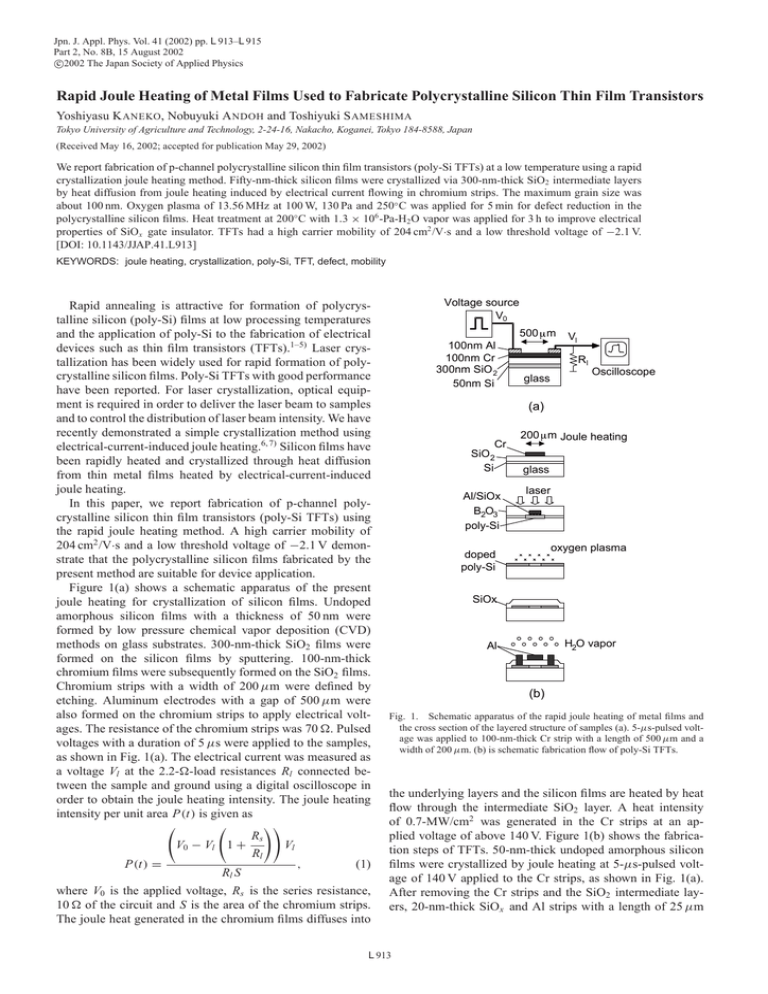Rapid Joule Heating of Metal Films Used to Fabricate Polycrystalline
advertisement

Jpn. J. Appl. Phys. Vol. 41 (2002) pp. L 913–L 915 Part 2, No. 8B, 15 August 2002 c 2002 The Japan Society of Applied Physics Rapid Joule Heating of Metal Films Used to Fabricate Polycrystalline Silicon Thin Film Transistors Yoshiyasu K ANEKO, Nobuyuki A NDOH and Toshiyuki S AMESHIMA Tokyo University of Agriculture and Technology, 2-24-16, Nakacho, Koganei, Tokyo 184-8588, Japan (Received May 16, 2002; accepted for publication May 29, 2002) We report fabrication of p-channel polycrystalline silicon thin film transistors (poly-Si TFTs) at a low temperature using a rapid crystallization joule heating method. Fifty-nm-thick silicon films were crystallized via 300-nm-thick SiO2 intermediate layers by heat diffusion from joule heating induced by electrical current flowing in chromium strips. The maximum grain size was about 100 nm. Oxygen plasma of 13.56 MHz at 100 W, 130 Pa and 250◦ C was applied for 5 min for defect reduction in the polycrystalline silicon films. Heat treatment at 200◦ C with 1.3 × 106 -Pa-H2 O vapor was applied for 3 h to improve electrical properties of SiOx gate insulator. TFTs had a high carrier mobility of 204 cm2 /V·s and a low threshold voltage of −2.1 V. [DOI: 10.1143/JJAP.41.L913] KEYWORDS: joule heating, crystallization, poly-Si, TFT, defect, mobility Rapid annealing is attractive for formation of polycrystalline silicon (poly-Si) films at low processing temperatures and the application of poly-Si to the fabrication of electrical devices such as thin film transistors (TFTs).1–5) Laser crystallization has been widely used for rapid formation of polycrystalline silicon films. Poly-Si TFTs with good performance have been reported. For laser crystallization, optical equipment is required in order to deliver the laser beam to samples and to control the distribution of laser beam intensity. We have recently demonstrated a simple crystallization method using electrical-current-induced joule heating.6, 7) Silicon films have been rapidly heated and crystallized through heat diffusion from thin metal films heated by electrical-current-induced joule heating. In this paper, we report fabrication of p-channel polycrystalline silicon thin film transistors (poly-Si TFTs) using the rapid joule heating method. A high carrier mobility of 204 cm2 /V·s and a low threshold voltage of −2.1 V demonstrate that the polycrystalline silicon films fabricated by the present method are suitable for device application. Figure 1(a) shows a schematic apparatus of the present joule heating for crystallization of silicon films. Undoped amorphous silicon films with a thickness of 50 nm were formed by low pressure chemical vapor deposition (CVD) methods on glass substrates. 300-nm-thick SiO2 films were formed on the silicon films by sputtering. 100-nm-thick chromium films were subsequently formed on the SiO2 films. Chromium strips with a width of 200 µm were defined by etching. Aluminum electrodes with a gap of 500 µm were also formed on the chromium strips to apply electrical voltages. The resistance of the chromium strips was 70 . Pulsed voltages with a duration of 5 µs were applied to the samples, as shown in Fig. 1(a). The electrical current was measured as a voltage Vl at the 2.2--load resistances Rl connected between the sample and ground using a digital oscilloscope in order to obtain the joule heating intensity. The joule heating intensity per unit area P(t) is given as Rs Vl V0 − Vl 1 + Rl , (1) P(t) = Rl S where V0 is the applied voltage, Rs is the series resistance, 10 of the circuit and S is the area of the chromium strips. The joule heat generated in the chromium films diffuses into Voltage source V0 500 m 100nm Al 100nm Cr 300nm SiO 2 50nm Si Vl Rl glass Oscilloscope (a) Cr SiO 2 Si Al/SiOx B2O3 poly-Si 200 m Joule heating glass laser oxygen plasma doped poly-Si SiOx H2O vapor Al (b) Fig. 1. Schematic apparatus of the rapid joule heating of metal films and the cross section of the layered structure of samples (a). 5-µs-pulsed voltage was applied to 100-nm-thick Cr strip with a length of 500 µm and a width of 200 µm. (b) is schematic fabrication flow of poly-Si TFTs. the underlying layers and the silicon films are heated by heat flow through the intermediate SiO2 layer. A heat intensity of 0.7-MW/cm2 was generated in the Cr strips at an applied voltage of above 140 V. Figure 1(b) shows the fabrication steps of TFTs. 50-nm-thick undoped amorphous silicon films were crystallized by joule heating at 5-µs-pulsed voltage of 140 V applied to the Cr strips, as shown in Fig. 1(a). After removing the Cr strips and the SiO2 intermediate layers, 20-nm-thick SiOx and Al strips with a length of 25 µm L 913 Jpn. J. Appl. Phys. Vol. 41 (2002) Pt. 2, No. 8B 0.2 m Fig. 2. Micrograph of the bright field image of transmission electron microscope (TEM) plane view for 50-nm-thick silicon films crystallized by the rapid joule heating of metal films at 140 V. 700 Capacitance (pF) were formed on the channel regions of the polycrystallized silicon films. A dopant source of 150-nm-thick B2 O3 layer was formed on the sample surface by spin coating of an organic liquid which consisted of an organic binder and B2 O3 molecules. The samples were irradiated with XeCl excimer laser pulses at 420 mJ/cm2 . Boron atoms were diffused into the silicon films and doped silicon films were formed. A conductivity of 22 S/cm was achieved in the doped silicon. Hall effect current measurements revealed a carrier concentration of 4 × 1019 cm−3 . In contrast, the silicon region below the Al layer was not heated by laser irradiation due to reflectance of laser light. After removing the dopant films and Al/SiOx films, 13.56 MHz oxygen plasma at 100 W, 130 Pa at 250◦ C was applied for 5 min for defect reduction in the polycrystalline silicon films.8) After silicon island formation, 280-nmthick SiOx films were formed as the gate insulator by thermal evaporation of SiO powders at room temperature.9) Contact holes were opened and then Al gate, source and drain electrodes were formed. After formation of the TFT structure, TFTs were heated at 200◦ C with 1.3 × 106 Pa-H2 O vapor for 3 h for oxidation of SiOx .10, 11) C–V measurement determined the dielectric constant of SiOx and the density of defect states. The silicon layers were rapidly heated and crystallized by heat diffusion from the hot chromium layers at the applied voltage of 140 V. Figure 2 shows a micrograph of the bright field image of the transmission electron microscope (TEM) plane view for silicon films crystallized by the present method at 140 V. The silicon region underlying the Cr strips was completely crystallized. Fine crystalline grains with sizes ranging between 50 and 100 nm were closely formed. Figure 3 shows capacitance responses with the gate voltage with a frequency of 1 MHz for Al gate metal-oxidesemiconductor (MOS) capacitors with the present SiOx asfabricated and annealed at 200◦ C with 1.3 × 106 Pa H2 O vapor for 3 h. A sharp capacitance transition was observed. From the curve of capacitance versus gate voltage, the specific dielectric constant of the SiOx layer, the densities of interface traps and fixed oxide charges were estimated to be 16.8, 2.0 × 1010 cm−2 ·eV−1 and 7.1 × 1011 cm−2 , respectively, for as fabricated MOS capacitors. The high-pressure H2 O vapor Y. K ANEKO et al. 600 as fabricated 500 400 After H2O vapor treatment 300 200 100 0 -3 -2 -1 0 1 Gate voltage (V) 2 Fig. 3. C–V characteristics at 1 MHz for Al gate metal-oxide-semiconductor (MOS) capacitors with SiOx as fabricated and treated with 1.3 × 106 -Pa-H2 O vapor heating at 200◦ C for 3 h. The area of gate Al metal was 5.5 × 10−3 cm2 . -25 Draincurrent ( A) L 914 -20 W/L=70 m/25 m SiOx=280nm Gatevoltage=-5V -15 -4V -10 -3V -5 -2V 0 0 -1 -2 -3 -4 Drain voltage (V) Fig. 4. Output characteristics of p-channel poly-Si TFTs with a channel length of 25 µm and a channel width of 70 µm. heat treatment oxidized SiOx layers so that the maximum oxide capacitance decreased as shown in Fig. 3. The specific dielectric constant of the SiOx layer, the densities of interface traps and fixed oxide charges were estimated to be 4.9, 2.0 × 1010 cm−2 ·eV−1 and 3.4 × 1010 cm−2 , respectively, after the H2 O vapor heat treatment. The density of the fixed oxide charges was markedly reduced because of the reduction of silicon dangling bonds in SiOx films. Figure 4 shows the output (Id -Vd ) characteristics of the pchannel poly-Si TFT with a channel length of 25 µm and a channel width of 70 µm. It shows good ohmic characteristics and a high drain current. Figure 5 shows the transfer characteristic of the TFTs. The threshold voltage was −2.1 V. The maximum effective carrier mobility in the linear region was 204 cm2 /V·s. The minimum subthreshold slope was 0.25 V/decade. The results of Figs. 4 and 5 indicate that the polycrystalline silicon films formed by the present joule heating method have sufficient quality for TFT operation. In order to estimate the density of defect states in polycrystalline silicon films, transfer characteristics were analyzed using a numerical calculation program, which was constructed with the finite-element method combined with statistical thermodynamical conditions with defect states localized at SiO2 /Si interfaces as well as silicon films.12, 13) We introduced the deep-level defect states localized at the mid gap, which had a Gaussian-type energy distribution. Tail- Jpn. J. Appl. Phys. Vol. 41 (2002) Pt. 2, No. 8B -10 -5 Y. K ANEKO et al. calculated Drain current (A) -10 -6 -10 -7 experimental -10 -8 -10 -9 -10 -10 -10 -11 -10 -12 -5 SiOx=280 nm W/L=70 m/25 m Vd=-0.1 V -4 -3 -2 -1 Gate voltage (V) 0 1 Fig. 5. Transfer characteristics of p-channel poly-Si TFTs. The solid curve is experimental drain current and the dashed curve is calculated drain current. state-type defect states were also introduced. The density exponentially decreased from the valence band as well as the conduction band edges to the deep energy level in the band gap. The defect states were placed uniformly in the silicon films. The density of defect states at SiO2 /Si interfaces was determined by C–V measurements of MOS capacitors to be 2 × 1010 cm−2 ·eV−1 . The best agreement of calculated transfer characteristics to experimental ones resulted in the density of defect states. The calculated drain current is shown by the dashed curve in Fig. 5. The calculation suggested that the silicon channel of the present TFTs had duplicate tail states with widths of 0.04 eV and 0.26 eV. The densities of unoccupied tail states in the flat band condition was 3.8 × 1011 cm−2 for the width of 0.04 eV and 1.9 × 1011 cm−2 for 0.26 eV. The density of unoccupied states at mid gap was 2.0 × 1011 cm−2 ·eV−1 . The low density of defect states enabled a marked increase in the hole carrier density with a low gate voltage application. In summary, the rapid heating properties of joule heating induced by electrical current flowing in chromium strips were employed in order to crystallize 50-nm-thick silicon films for fabrication of poly-Si TFTs. The application of pulsed voltage at 140 V for 5 µs caused a rapid crystallization of the silicon films with a maximum grain size of 100 nm via 300-nm-thick L 915 SiO2 intermediate layers. P-channel poly-Si TFTs were fabricated by the formation of a boron-doped source drain region using the laser-doing method. Defect reduction treatment of 13.56 MHz-oxygen plasma at 100 W, 130 Pa at 250◦ C was applied for 5 min to the crystallized silicon films. Heat treatment at 200◦ C with 1.3 × 106 -Pa-H2 O vapor was for 3 h also applied after TFT fabrication in order to improve electrical properties of SiOx gate insulator. Poly-Si TFTs had high carrier mobility of 204 cm2 /V·s and low threshold voltage of −2.1 V. The numerical calculation suggested that tail-type defect were dominant in the silicon films. The densities of unoccupied tail states in the flat band condition are 3.8 × 1011 cm−2 for a width of 0.04 eV and 1.9 × 1011 cm−2 for 0.26 eV. The results indicate that the polycrystalline silicon films formed by the present joule heating method have sufficient good quality for TFT operation. The authors thank Professors T. Mohri and T. Saitoh for their support. 1) T. Sameshima, S. Usui and M. Sekiya: IEEE Electron Device Lett. 7 (1986) 276. 2) K. Sera, F. Okumura, H. Uchida, S. Itoh, S. Kaneko and K. Hotta: IEEE Trans. Electron Devices 36 (1989) 2868. 3) T. Serikawa, S. Shirai, A. Okamoto and S. Suyama: Jpn. J. Appl. Phys. 28 (1989) L1871. 4) A. Kohno, T. Sameshima, N. Sano, M. Sekiya and M. Hara: IEEE Trans. Electron Devices 42 (1995) 251. 5) H. Kuriyama, T. Kuwahara, S. Ishida, T. Nohda, K. Sano, H. Iwata, S. Noguchi, S. Kiyama, S. Tsuda, S. Nakano, M. Osumi and Y. Kuwano: Jpn. J. Appl. Phys. 31 (1992) 4550. 6) T. Sameshima, Y. Kaneko and N. Andoh: Appl. Phys. A 73 (2001) 419. 7) T. Sameshima, Y. Kaneko and N. Andoh: Appl. Phys. A 74 (2002) 719. 8) Y. Tsunoda, T. Sameshima and S. Higashi: Jpn. J. Appl. Phys. 39 (2000) 1656. 9) T. Sameshima, A. Kohno, M. Sekiya, M. Hara and N. Sano: Appl. Phys. Lett. 64 (1994) 1018. 10) K. Sakamoto and T. Sameshima: Jpn. J. Appl. Phys. 39 (2000) 2492. 11) K. Asada, K. Sakamoto, T. Watanabe, T. Sameshima and S. Higashi: Jpn. J. Appl. Phys. 39 (2000) 3883. 12) P. V. Evans and S. F. Nelson: J. Appl. Phys. 69 (1991) 3605. 13) M. Kimura, R. Nozawa, S. Inoue, T. Shimoda, B. O. Lui, S. W. Tam and P. Migliorato: Jpn. J. Appl. Phys. 40 (2001) 5227.




